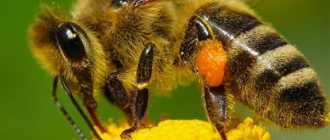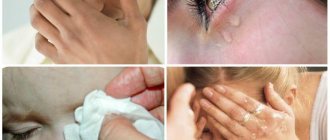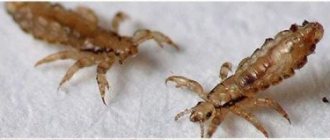Honey Place / Bees / Bee Sting
0
How nice it is to relax in nature or near a pond in the warm season! But you need to understand that it is the fragrant smell of flowering plants or your food supplies, especially fruits and sweets, that attract bees. A bee sting is very painful and even dangerous if a person is allergic to the insect's venom.
Bee sting
The unpleasant sensations from a bee sting are accompanied by itching and redness. It is worse if the listed symptoms are accompanied by high fever and swelling of the respiratory tract. You will learn about first aid for a bite, allergic symptoms and much more from our article.
Why do bees attack people and animals?
An attack by bees, hornets, wasps is not a completely accurate formulation, because insects do not attack without a reason. They may become angry with a person or dog because of a destroyed nest, an attempt to take away their supplies, because of sudden movements or constant disturbance from living creatures. Only in this case will the angry insect try to escape. It bites, leaves a sting and most often dies.
Why does a bee die after being stung? The insect drives its sting tightly into the human skin, and when it tries to fly away, it cannot reach it. The stinger comes off, and with it most of the bee's intestines. After a few minutes the insect dies.
Note that bees have amazing sensitivity to odors, they are especially irritated by the aromas of onions and garlic, and sweat. Bees often attack drunk people: the smell of alcohol or cigarettes is also not to their taste.
But a bright floral trail of perfume will attract a bee. If you try to drive it away, it is clear what will happen next: a bee sting, swelling, several days of discomfort.
How to prevent being bitten
The first and most important tip is to remain still. This helps a lot. If bees are flying nearby, it is better to freeze. Under no circumstances should you wave your hands, this will anger the insects. Also, do not be afraid of panic, since a person’s feeling of fear increases the bee’s aggression.
You should be careful if you have a desire to eat sweets. Insects are attracted to this. There is a danger that a bee will get on your tongue.
When going outdoors, you should choose clothes in calmer colors; bright things attract the attention of bees and will become an irritant for them. It is also worth wearing clothes that cover exposed areas of the body as much as possible. It is equally important to ensure that insects do not get under clothing.
On a note. Bees are also attracted to strong odors, such as cologne or alcohol.
Bee stings cause a lot of inconvenience, some even threaten life, so if possible, you should avoid contact with them and do not provoke or irritate the insects. If a bite does occur, first aid should be provided promptly and quickly to the victim.
How to avoid being bitten: rules of conduct
How to avoid these insect bites? Trying to ward off the insect with a towel or something similar will end badly. Calm behavior will not cause aggression, and you can protect yourself from a bee sting.
If you see insects near you, do not panic, stop waving your arms or chasing them away
It is worth explaining to young children that insects cannot be caught and driven away. During the warm season, your baby can eat ice cream or something sweet outside. Keep an eye on him, because there are often cases when a child puts a bee in his mouth along with a piece of goodies. Such examples are quite sad. When stung, the child becomes frightened, and bites on the tongue or palate are painful and can cause severe allergies.
You should also not kill an insect: the smell of its poison will attract even more of its relatives. If an insect flies into your open window, catch it with a towel and release it outside. Despite the potential danger, bees are very useful insects that provide people with delicious honey, and their venom is used to make medicines.
Note that bee stings are not as dangerous as, for example, hornet stings. If the latter is affected, you may notice that your blood pressure has risen and your pulse has increased by 10–20 units.
No one is able to predict the moment at which a bee may sting, for this reason it is necessary to be able to provide first aid after a bee sting.
Bee sting - harm or benefit
Although bee stings can be harmful to health and dangerous for the elderly, children and allergy sufferers, there is also a direction called apitherapy. This trend in folk medicine suggests using bee stings to cure many different diseases.
We recommend reading! Caring for bees: advice and recommendations from professionals, basic rules of keeping and recommendations for breeding
Here no one thinks about how to remove a tumor if you are bitten by a bee, because the effect of their venom is considered therapeutic. In particular, with the help of apitherapy they treat high blood pressure, heart and blood diseases, inflammatory processes, improve the functioning of the immune, hormonal and enzyme systems, increase bone regeneration...
Despite excellent reviews about such treatment methods, you should not fall for fancy advertising and start apitherapy without consulting a competent doctor.
What are the consequences of insect bites: the reaction of the human body
Here are the consequences of the bites of these insects:
- Cell destruction, causing redness and inflammation.
- The poison contains a special toxin that has a strong effect on the central nervous system.
- A high concentration of histamine substances, which contribute to the development of swelling, redness and subsequent allergic reactions. Some people cannot tolerate bee venom, and when a bee stings their body reacts to it with severe swelling.
- Dissolving in the blood, the poison provokes the breakdown of red blood cells.
- Individual reaction of the body: difficulty breathing, weakness, severe or tolerable pain.
- Swelling forms at the site of the bite; its size and duration of treatment depend on the person’s body’s tolerance to the poison.
- You may notice that the wound is swollen and the redness around it is rapidly increasing.
- In rare cases, rapid heartbeat and deep fainting may occur.
Allergies most often affect young children and adolescents, and in these cases, you should immediately consult a doctor. If this is not possible, then it is better to give the child an approved anti-allergy drug and apply an anesthetic ointment to the damaged area.
How does the human body react to bee venom entering the bloodstream?
The reaction to a bee sting can vary, depending on whether the person is allergic
98% of people who do not suffer from allergies experience the following reaction:
- Redness with a diameter of up to 3 mm forms around the bite site.
- Body temperature rises by 2–3 degrees.
- The wound is itchy and hurts for the first 2 hours. The discomfort goes away after 2–3 days.
In case of allergies, a bite is accompanied by the following symptoms:
- Convulsions, fever, delirium.
- Shortness of breath and rash all over the body.
- Salivation, sweating, suffocation.
Some pictures depict the swelling that accompanies allergies: swollen eyes, swollen lips, etc. This reaction can only be neutralized with strong medications. And if after a bite a person feels very bad, immediately call an ambulance.
A congenital or acquired allergy to bee venom is not a big deal. People suffering from it are advised to carry an emergency first aid kit with them at all times. In the first aid kit, put the necessary medications, syringes, alcohol, cotton wool, do not forget to put a piece of paper in it with your name, address and instructions with the procedure.
Bee sting: benefits
In conclusion, I would like to say that bee venom is not so destructive to the body. According to the developments of many scientists, the substances contained in it can be useful. There is a whole direction in medicine based on treatment with bee venom - apitherapy.
The same components that cause negative reactions also have a therapeutic effect. It has been proven that bee venom:
- improves metabolic processes in the body;
- reduces the activity of inflammatory processes;
- activates the production of hormones;
- normalizes the enzymatic composition in the body;
- suppresses the activity of harmful bacteria;
- has an antispasmodic effect;
- has an analgesic effect;
- helps with hypotension;
- normalizes heart rhythm;
- stimulates the immune system;
- has an anticoagulant effect;
- increases the content of red blood cells in the blood;
- improves microcirculation, etc.
Treating the consequences of a bee sting at home
After extraction, the wound is washed with potassium permanganate or wiped with alcohol, and carefully treated with iodine. All procedures are carried out very carefully. The most painful is a bee sting in the eye, palate, tongue, cheek, head, neck.
After removing the sting, the wound is washed with potassium permanganate or wiped with alcohol, and carefully treated with iodine.
You can treat the bite site and relieve swelling with the following medications:
- Apply cotton wool or a piece of gauze with a small amount of Psilo-Balm or Elokom to the bite site. You can also use Hydrocortisone, Soventol or Fenistil-gel ointment.
- To relieve swelling, apply a wet bandage or ice previously wrapped in a bag to the damaged area.
- To prevent allergies, it is recommended to take antihistamines for 1–3 days: Ephedrine, Suprastin, Diphenhydramine, Pipolfen. It is recommended to drink an antihistamine for bee stings until the swelling completely subsides.
- A Validol tablet soaked in water, a cotton swab dipped in Menovazin or a calendula solution will help numb the wound.
Do not give the victim hot drinks: under the influence of hot water, bee venom is absorbed into the blood faster. But cool and even cold water can be used in large quantities to help the body cleanse itself more quickly.
What to do if you don’t have the necessary medicines at hand: folk remedies
If there is no medicine at hand, then the wound can be treated with vodka or other strong alcohol. And this is missing? Then wipe the wound with chopped parsley, plantain, apply aloe vera or garlic juice, these are proven folk remedies for bites. They will help relieve swelling, pain and temporarily disinfect the wound.
The following remedies for bee stings will help draw out the poison and relieve swelling:
- A piece of sugar, previously soaked in water and applied to the wound.
- A parsley decoction (2 tablespoons of parsley root pour 500 ml of boiling water) can help relieve a mild allergic reaction.
- Apply a cut apple or potato to the wound.











